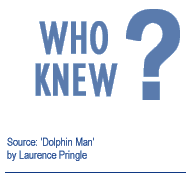|
 INTERACTIVE CURRICULUM NOW AVAILABLE INTERACTIVE CURRICULUM NOW AVAILABLE
Explore the Secret Life of Dolphins
A new curriculum designed for middle and high school students probes the secret life of dolphins. The project is a partnership of the Brookfield Zoo and Mote Marine Lab with funding from the U.S. Department of Education. Slated for release in February, the multi-media curriculum includes a binder with background information, lesson plans and activities, and a CD-rom with software enabling students to analyze and compare real data collected by researchers in Sarasota and at the Brookfield Zoo. A third component, video conferencing, brings researchers and their dolphin friends right into the classroom for live, interactive learning sessions. For more information, visit www.seatrek.org or contact Elizabeth Metz at 1-800-691-MOTE.

 Dolphin Talk: January 20 Dolphin Talk: January 20
Dr. Randy Wells will be appearing at the Florida Aquarium, Thursday, January 20, for a presentation on Dolphin Family Values: Bottlenose Dolphin Research, as part of the aquarium's Evening Tide lecture series. Reception starts at 5:45 p.m., followed by a presentation at 6:15 p.m. Call 813-273-4189 to RSVP.

 |
- All dolphins are toothed whales.
- Bottlenose dolphins are one of 32 species of dolphins worldwide.
- The few species that are called porpoises have spade-shaped teeth and blunt, rounded faces.
- True dolphins have teeth shaped like rounded cones set in jaws that extend in a snout or beak.
- The biggest dolphin is the killer whale, which may grow to be 32 feet long. The smallest, just five feet long, is the tucuxi, which lives in the freshwater Amazon river and brackish coastal waters of South America.
- Dolphin teeth are used for grasping, not chewing. A dolphin grabs its prey, then swallows it whole.
- A female bottlenose dolphin nursing a calf may eat as much as 30 pounds of fish a day.
|

|

Echo & Misha:
15 Years Back in Tampa Bay
It has been 15 years since Echo and Misha were returned to their native Tampa Bay following a two year stay at California's Long Marine Observatory. The male bottlenose dolphins were initially captured in July 1988 and flown to Santa Cruz for in-depth echolocation studies. Two years later they were returned to Tampa Bay and released together near Bishop Harbor in Misha's original home range. Within a short period of time, both animals were socializing with local dolphins and displaying typical, healthy behaviors. After the first few months back in the wild, Echo returned to his own home range and was most recently sighted near downtown St. Petersburg in August 2003.
Researchers have identified five separate communities of dolphins in Tampa Bay based on patterns of association and home ranges. Scientists are analyzing genetic samples of dolphins within these communities to determine how much inter-breeding occurs. Twenty-five biopsy samples were collected from Tampa Bay dolphins last summer, adding to the growing genetic catalog of dolphins along the west coast of central Florida, which now includes almost 30 samples from each of the bay's five communities. Recent photo surveys confirm that a large proportion of dolphins first identified in Tampa Bay in the late 1980s still frequent these waters. Results of the gene flow analysis are expected this Spring.
|

